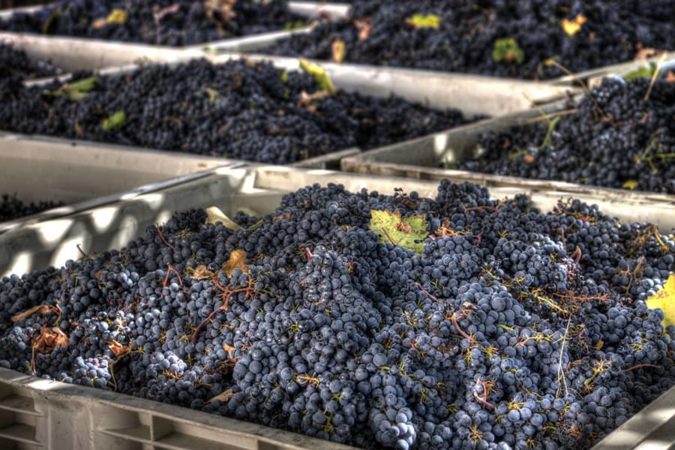How many calories are in black grapes?
In pursuit of the body of their dreams, many completely exclude high-calorie and tasty foods from their diet, exhausting themselves with strict diets, sometimes not suspecting that some of their favorite foods can be consumed daily without harming their figure. One of them is black grapes. It promotes weight loss and improved well-being. If you follow the daily norm, grapes will have a positive effect on the functioning of the whole body.
How many calories are in black grapes
Black grapes are an assistant in the fight against exhaustion, stress and chronic fatigue due to their high calorie content. Flavonoids cleanse blood vessels, block the deposition of cholesterol on their walls, strengthen the heart, and remove inflammation. Black grapes improve appetite, normalize metabolism and the composition of gastric juice.

Calorie content depending on variety

Black grapes themselves are considered low in calories. The nutritional value of 100 g ranges from 65 to 75 kcal.
However it all depends on the sugar level: the higher the sweetness, the fruits have more calories.
There are different varieties of crops:
- Kishmish — 100 g of berries contain approximately 95 kcal;
- Baikonur - no more than 70 kcal per 100 g;
- Moldova - 65 kcal per 100 g;
- Isabella - 66 kcal per 100 g.
The nutritional value of grapes does not change due to the absence of seeds. As a rule, they are not used for food - only the fleshy part is eaten.
Glycemic index and BJU
This is an indicator of how quickly the carbohydrates in a product are broken down in the body and absorbed, causing an increase in blood glucose levels.Its glycemic index is 100. GI of black grapes is 44–50 units.
Important! Some are accustomed to peeling grapes, although they contain many vitamins and minerals.
100 g of fruit contains 16.8 g of carbohydrates, 0.6 g of protein and only 0.2 g of fat.
Composition and properties
The berries contain vitamins B1, B2, B5, B6, B9, C, E, H, A, beta-carotene, mono- and disaccharides, and minerals.
Basic:
- Potassium. Its daily intake for adults is 2–2.5 g; 100 g of grapes contains 225 mg. The element regulates the water-salt balance in the body, is good for the heart, and is involved in the transmission of signals from nerve endings.
- Phosphorus - an assistant in the absorption of glucose. It restores the functioning of the nervous system, maintains a high pH level, strengthens bones, nails and teeth. The daily norm is 1 g; 100 g of berries contain 22 mg of phosphorus.
- Calcium. Required for strong teeth and bones. It makes muscles elastic and increases neuromuscular conduction. The daily norm is 1 g, the product contains 30 mg.
- Magnesium. Important for the prevention of cardiovascular diseases, supports the functioning of the nervous system, and is involved in many enzymatic reactions and protein synthesis. Daily norm - 400 mg, per 100 g dark grapes it contains 17 mg.
- Iron. Normalizes hemoglobin levels, stimulates the functioning of the immune and nervous systems, plays a significant role in the formation of bones and the synthesis of thyroid hormones. The daily value is 18 mg, the product contains 0.6 mg per 100 g.
- Silicon. Increases immunity, has anti-inflammatory and antioxidant effects, increases the strength of bones and capillaries, improves the condition of hair, nails and skin. The daily norm is 30 mg, 100 g of berries contain 12 mg of silicon.
The composition contains malic, citric, succinic, oxalic and other organic acids. They normalize digestion and metabolism, tone the cardiovascular and nervous systems, have antioxidant properties, regulate energy exchange in cells and increase resistance to oxygen deficiency.
Reference. Malic acid, which contains 2–5 g per 100 g of ripe grapes, has immunomodulatory, expectorant properties, and improves the tone of blood vessels.
Berries normalize heart rate, tone the body, cleanse toxins due to pectin substances, and stimulate the production of gastric juice.
How many calories are in 100 ml of juice

Grape juice consists of 70–80% water and dissolved solids: sugar, organic acids, phenolics, nitrogenous and aromatic compounds. When consumed, the drink is quickly absorbed and increases hemoglobin levels and the number of red blood cells. The juice removes toxins from the body, cleansing the blood and liver. The calorie content of the drink is 54 kcal per 100 ml.
In processed berries
A product that has been heat-treated or sun-dried increases its calorie content significantly. So, in dried grapes it is 264 kcal per 100 g.
Sweet or savory jam contains 190 kcal per 100 g.
Compared to dried grapes and jam, canned berries are low in calories: nutritional value per 100 g is 40 kcal.
Is it possible to eat black grapes while losing weight on a diet?
Contrary to popular belief that eating grapes when losing weight is prohibited due to their high sugar content, this berry is an excellent fighter against excess weight.It saturates for a long time, improves the psycho-emotional state and metabolism, cleanses the gastrointestinal tract and promotes the production of gastric juice.

Benefits and harms
Benefits of berries for the body:
- rapid satiety due to high calorie content, which prevents frequent feelings of hunger;
- cleansing of toxins;
- reducing the risk of cancer;
- slowing down cell aging;
- rejuvenation and toning of the skin due to vitamins A and E;
- mild laxative effect;
- improving vision by normalizing the permeability of eye capillaries and reducing the risk of cell damage from free radicals.
Nutritionists recommend eating grapes with seeds to get more nutrients.
Grapes can harm the body if they are contraindicated for humans.
Main reasons:
- Gastrointestinal diseases, ulcers. The skin of the berries negatively affects the walls of the stomach, irritating them. If you use the product for a long time, there is a risk of exacerbation of diseases.
- Diabetes. Due to the high amount of sugar, it is better for people with this disease to avoid eating grapes.
- Obesity.
- Caries, stomatitis. The acids in the composition increase the destruction of tooth enamel.
- Allergy.
- Kidney and liver disease.
It is recommended to eat grapes with caution and after prior consultation with your doctor. pregnant women women and children under 3 years of age.
How to choose and store correctly

Suitable storage temperature for fruits is 0…+7°C. In such conditions they will remain fresh from several weeks to several months.
Important! It is not recommended to wash the berries, because moisture will accelerate rotting.
Storing grapes in polyethylene (unless frozen) is not recommended: condensation will cause rotting.
In the refrigerator, the fruits are kept in the fruit compartment at a temperature of -1...+2°C for several weeks. Low-quality specimens are first removed and the berries are periodically inspected.
The fruits are stored in the freezer for several months, but re-freezing is not allowed so as not to lose the taste. The berries are placed in plastic bags or wrapped in cling film.
If there are a lot of grapes, they are put on the balcony, in a cardboard or wooden box. Periodically check for the presence of rotten, spoiled fruits. Otherwise, the shelf life will be shortened, as rotting will grow rapidly.
Basic recommendations for choosing berries:
- take grapes with large bunches;
- the fruits should be elastic and whole, with a dense skin, without dents;
- carefully examine the berries located closer to the branch, since this is where the first signs of spoilage appear;
- if the “tail” of the fruit has dried up, it means that the grapes were picked a long time ago.
At the market, it is better to buy grapes that are located at a distance, since usually goods are laid out on a nearby counter for quick sale. If wasps fly over the boxes, it means the berries are of excellent quality.
Dosage per day
The consumption rate per day for an adult, according to nutritionists, is 15–50 berries per day - approximately 200 g. On a diet, the amount is reduced to 100–150 g.
Conclusion
Grapes are rich in vitamins and minerals, flavonoids, organic acids and pectins. Strengthens and tones the cardiovascular, nervous, and digestive systems, improves the condition of the skin, hair and nails. When consumed no more than 200 g per day on a diet, berries will help lose weight and heal the body.